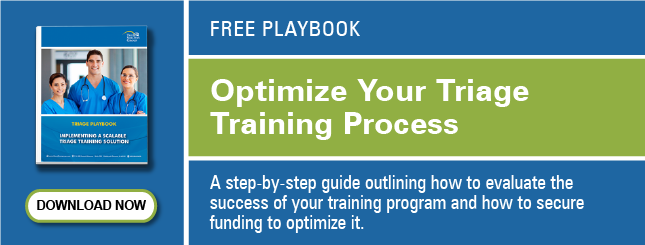Triage is an essential part of any busy emergency department (ED), but it is often undervalued. While triage is not designed to determine the cause of a patient’s symptoms, it prioritizes the patient’s need to be seen by a provider. EDs often assume (possibly erroneously) that triage assessments are being performed correctly or that any errors in triage can be corrected when the medical screening is done. Both assumptions can lead to serious adverse patient events.
There are two potentially significant problems that a faulty triage process can introduce into the ED.
The first is delays in screening or evaluating critically ill or injured patients.
TSG has for many years promoted the concept of seconds-to-minutes emergencies. The overall door-to-bed time may be nebulous and not specific enough to result in a focused response. Therefore, we focus on certain complaints that stand out as the highest risks presenting to triage, including abdominal and chest pain patients over 40, neonates with fever, visual loss, neuro deficit, and a swollen or painful testicle. In these cases, time is tissue or morbidity/mortality.
Everyone on the ED team and in hospital administration can get behind quality improvement in this critical area. Improvement starts with seconds-to-minutes presentations, and those gains improve operations throughout the triage process. We have partnered with d2i to automatically pull data from ED medical records to report on how often the seconds-to-minutes presentations are managed appropriately. The data—particularly post-COVID—coupled with a boarding crisis, is alarming!
In the case of Scruggs v. Danville Regional Medical Center, the patient was a diabetic who complained of having “dry heaves.” The nurse in triage failed to note that the patient was a diabetic and assessed him as “non-urgent.” The patient was not seen by a physician for 11½ hours, at which time a blood sugar analysis and IV fluids were ordered. Approximately 40 minutes after being seen by the physician, the patient became unresponsive and went into cardiac arrest, which was successfully resuscitated. Although the decision does not specifically state this fact, it appears that the patient was suffering from diabetic ketoacidosis.
The court denied the hospital’s motion to dismiss on the grounds that it could not say, as a matter of law, that the evaluation at triage constituted an appropriate screening under EMTALA. This case also points to the issue that triage can often be a “one and done” process—patients are triaged once, and they are not re-triaged or seen by anyone until screening.
The second key issue involves two heuristics (cognitive dispositions to respond) that can start the provider down an incorrect path during medical screening and evaluation: (1) triage cueing and (2) geography is destiny.
In triage cueing, emergency medical providers often look at what has already transpired prior to seeing a patient, such as a transfer note, urgent care record, or the triage note. Those notes cue the provider as to what may be happening with the patient. They may also bias the patient or anchor the provider on the cause of the patient’s condition or presentation.
In Barkes v. River Park Hospital, Inc., the patient informed the paramedic in triage that he had pain in his left wrist after clearing brush on his property. His wife later testified that the patient also said that he was “sick at his stomach,” but the paramedic denied that he had received this information.
Because the nurse practitioner who performed the medical screening exam and the collaborating physician were unaware that the patient was “sick at his stomach,” the NP focused—or anchored—on a possible musculoskeletal injury and missed the myocardial infarction that resulted in the patient’s death.
Geography is destiny is an interesting heuristic. Triage of patients with significant pathology to an ED’s non-urgent center or Fast Track instead of to the ED itself may be a death sentence. Those practitioners working in the Fast Track may assume that since the case is non-urgent and does not need a formal emergency room, things can’t be that bad. Any nurse or physician administrator who has run large EDs will be very familiar with this concept, as significant pathology may be overlooked only to bounce back to the ED and wind up in peer review.
There are two primary ways to determine whether there is a problem in triage or with a specific individual’s triage competency.
- The first is to encourage providers and nurses in the treatment area to report any adverse patient events (e.g., delays or misdiagnoses) as occurrences that could be attributable to a faulty assessment in triage. This should not be focused on blame or discipline, but rather on a need for additional or remedial instruction and training.
- The second is to periodically review a sample of patients who went through triage and were either admitted or transferred. If these patients were assessed as non-urgent in triage (e.g., a Level 4 or 5 on a 5-point scale), there may have been an issue with the triage assessment.
Triage is an area that is under-studied in many hospitals; this can lead to inadequate patient assessments resulting in patient injury and harm. System problems are not always obvious, and they cannot be discovered without studying the process.
References
Scruggs v. Danville Regional Medical Center. No. 4:08CV00005 (W.D. Va. Sept. 5, 2008).
West JC. Emergency medicine: Long delay in receiving care in the ED may be violation of EMTALA. Scruggs v. Danville Regional Medical Center, No. 4:08CV00005 (W.D. Va. Sept. 5, 2008). J Healthc Risk Manag. 2008;28(3):33-4. PMID: 23641481.
Barkes v. River Park Hospital, Inc. 328 S.W.3d 829 (Tenn. 2010).
Mohan D, Rosengart MR, Farris C, Fischhoff B, Angus DC, Barnato AE. Sources of non-compliance with clinical practice guidelines in trauma triage: a decision science study. Implement Sci. 2012 Oct 25;7:103. doi: 10.1186/1748-5908-7-103. PMID: 23098291; PMCID: PMC3503726.


